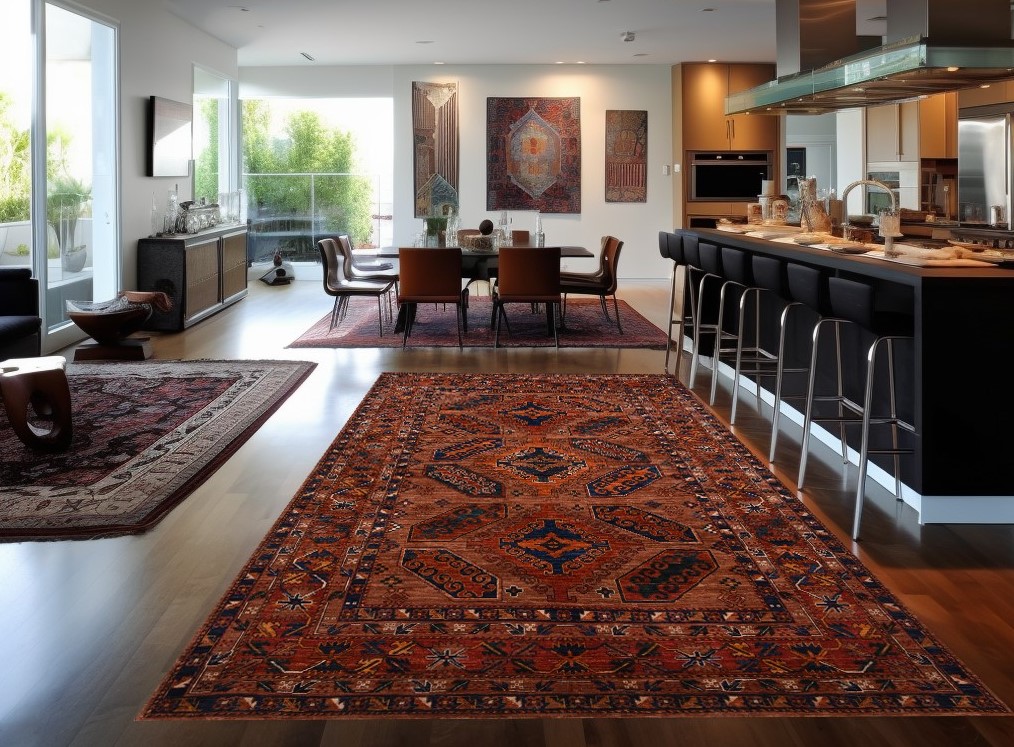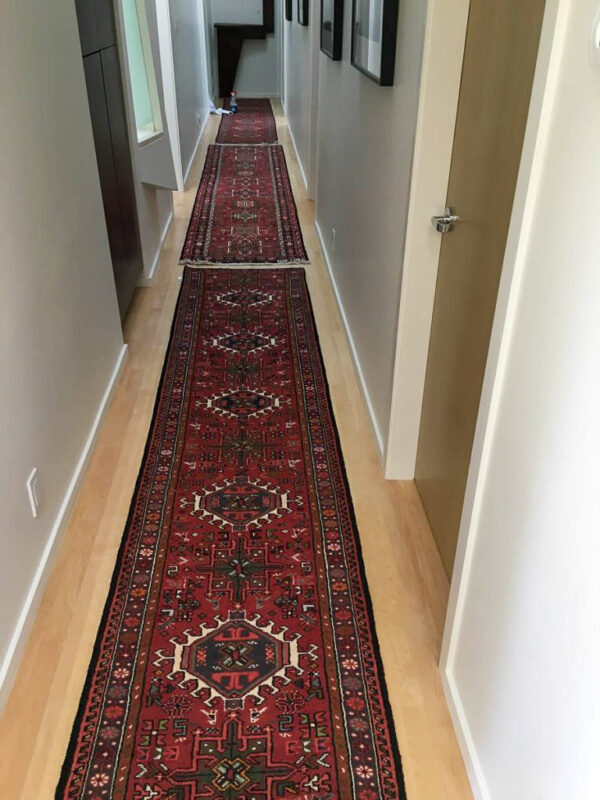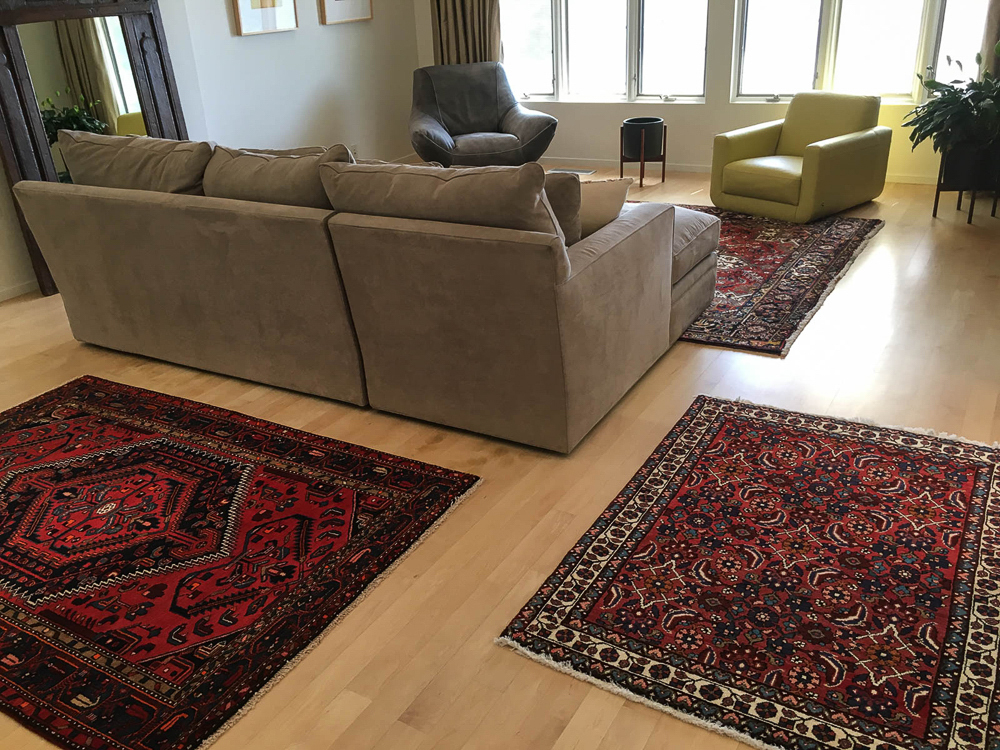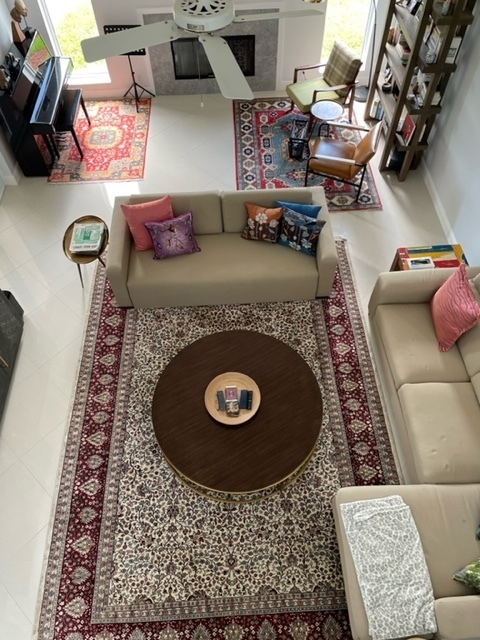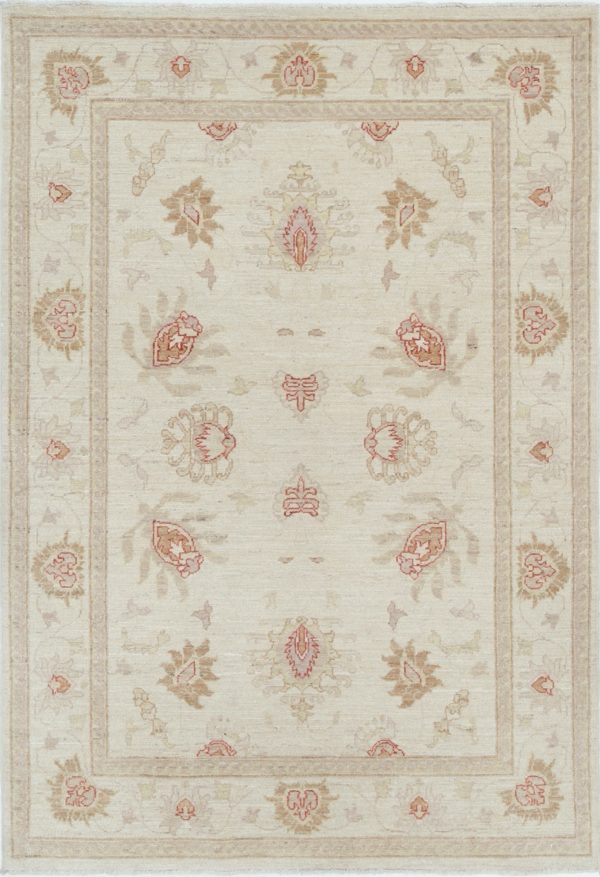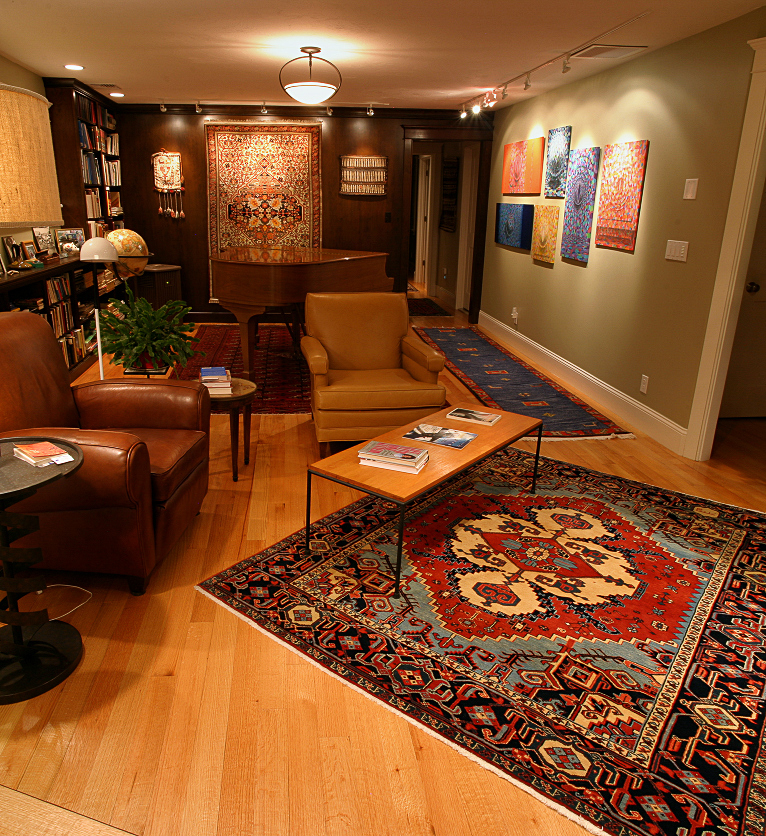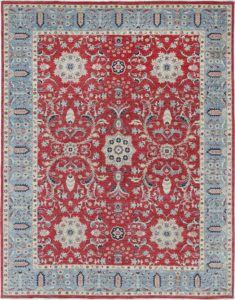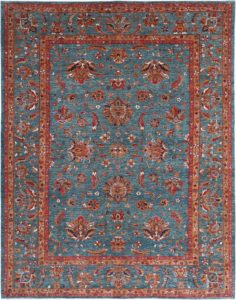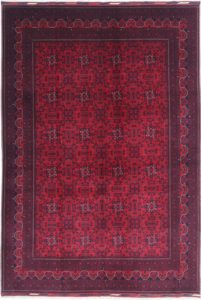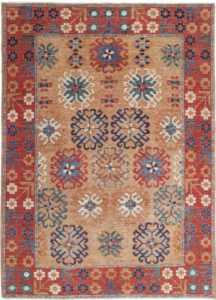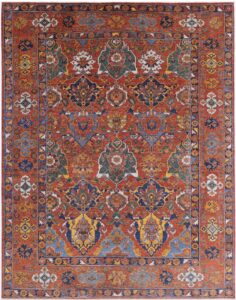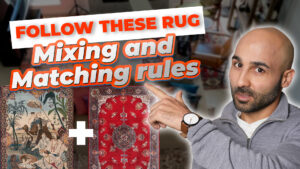Rug Pairing: Should You Mix and Match Rugs?
“Should you mix and match Oriental rugs?” It’s a question we often get asked:
The answer is a resounding yes, and we’re here to guide you through this process. With over 25 years of experience in the field, we’ve been helping our customers create stunning combinations of oriental rugs that complement each other and enhance the overall aesthetic of their spaces.
Table of Contents
Mixing and matching rugs is about balancing similarity and contrast, addressing the challenge head-on. Two rugs don’t have to be identical to look good together. A bit of contrast can add depth and visual interest to your space. The key is finding a common element, color, pattern, or style that can beautifully tie the rugs together, resolving the design dilemma and creating a harmonious and captivating environment.
Before delving into the specifics of mixing and matching different types of Oriental rugs, it’s essential to clarify the context in which this advice most applies. This guidance is primarily intended for scenarios where two or more rugs of different styles are placed in close proximity within the same room.
Specifically, consider situations where the rugs are within six feet of each other, adjacent, and visible simultaneously from various points in the room.
How to Separate Rugs
Suppose you’re finding it difficult to mix and match some oriental rugs. In that case, one option is to put furniture in between the rugs or keep them further away from each other so they’re not as visible when looking into this part of your home.
In an open area where you’re using multiple oriental rugs, it can sometimes be challenging to create a harmonious blend. Placing furniture, such as a sofa, coffee table, or bookshelf, between the rugs can create distinct zones while reducing the direct visual connection between the rugs. This can help if the rugs have contrasting styles or colors that don’t easily blend.
Another option is to increase the distance between the rugs. By keeping them further away from each other, each rug can stand independently and contribute to the overall decor without clashing with the other.
Color and Design
When it comes to mixing and matching multiple rugs, there are two components to pay attention to: the colors of the rugs and the design or patterns in the rug.
The color component is crucial to ensure different colors match and work harmoniously together. The design is also essential, but it’s not a must. If the colors match, the design doesn’t necessarily have to match, but it’s always nice to make the designs match.
Colors Overview
There are four different components of colors inside oriental rugs:
*The highlight colors that stand out
*The field of the rug (the background in the center of the rug)
*The border of the rug (the background color of the border)
*The color of the medallion, if the rug has one
Color Matching Rugs
You can match two oriental rugs together by matching their highlight colors.
For example, if you have a rug with solid blues or greens, you want to find that both rugs you’re trying to match have these highlight colors.
Another option is to match the field color or the border color. You can also match the color of the medallions if both rugs have the same color medallion.
Even if your rugs are from the same color family, they mustn’t be the same shade. You can create a layered, dynamic look by choosing rugs in different shades of the same color. For instance, you could choose light blue and dark blue if you work with blue rugs.
Design Overview
Design Matching
The best practice is that if you have patterned rugs like a floral design rug, you try to match that with another one. The same goes for geometric design. Geometric area rugs also work well with herati rugs.
Whether the design will be very intricate or more simplified, as long as the type of design is similar, that’s what matters the most.
Mixing different rug patterns can be fun and creative to add personality to your living space. Here’s how you can do it:
Stick to a Color Palette: Even if the patterns are different, sticking to a consistent color palette can create a sense of unity.
Balance Bold and Subtle: If one rug has a bold pattern, consider pairing it with a rug that has a more subtle pattern. This can prevent the space from looking too busy.
Play with Scale: Mixing patterns of different scales can add depth and interest. For instance, a rug with a large-scale pattern could be paired with a smaller, more intricate one.
Other Factors to Consider When Matching Area Rugs In The Same Room
Beyond the color and design of the rugs themselves, several other factors can significantly influence the success of your rug pairing.
The layout of your room plays a crucial role in determining how your rugs will interact with each other. The size and shape of the room, the positioning of furniture, and the traffic flow through the space can all impact how your rugs are perceived.
For instance, in a big, open floor plan, you might have more flexibility to experiment with different rug sizes and placements. Conversely, in a smaller or more segmented room, rugs of similar sizes might be more effective in maintaining balance and proportion.
The accent colors present in your room should be taken into account. These are the secondary colors used in your decor, such as the colors of your cushions, artwork, curtains, and other accessories. Ideally, the colors in your rugs should complement these accent colors, creating a cohesive and harmonious color scheme throughout the room.
For instance, if your room features many blue accents, you might choose rugs with blue highlights to tie the space together.
The color of your walls can significantly affect how your rugs are perceived. Light-colored walls can make colorful rugs pop, while darker walls might call for rugs with lighter or more vibrant colors to prevent the space from feeling too heavy.
It’s also worth considering the undertones of your wall color. For instance, if your walls have warm undertones (like beige or cream), rugs with warm colors (like red or orange) might work particularly well.
Do All Your Oriental Rugs Have To Match?
While matching oriental rugs can create a harmonious look, design dilemmas can arise. The key is to consider the overall cohesion and flow of the area.
By carefully selecting oriental rugs with a similar color palette, complementing each other rather than perfectly matching. Embrace the freedom to mix a patterned rug to create a curated and eclectic look.
Which Oriental Rug Goes With Everything?
Oriental rugs in neutral shades like beige, gray, or cream can be versatile addition to any room. Its simplicity allows it to blend seamlessly into various decor styles, from modern minimalist to rustic farmhouse. Acting as a subtle canvas, it lets the furniture and other decor elements shine, making it a rug that truly goes with everything.
Can You Mix and Match Antique Natural Fiber Rug With New Rugs?
Absolutely! Matching rugs like an antique and new rugs can create a stunning blend of traditional and contemporary styles. The intricate designs and rich colors of oriental rugs can beautifully contrast modern rugs’ clean lines and minimalist aesthetic. The key is to find a balance that works for your space.
For instance, an oriental rug with bold patterns could be paired with a modern rug with a small-scale pattern as long as they share the same color palette. This approach harmonized the different styles while still showcasing the unique qualities of each rug.
Alternatively, if the rugs share the same style – geometric or floral – they can be mixed and matched regardless of their origin. This would create a unified theme in the same room, seamlessly blending traditional and contemporary elements.
How To Use Multiple Rugs in The Living Room?
Layering living room rugs can add depth, texture, and a touch of personal style to your space. Here’s a step-by-step guide on how to do it:
Choose Your Rugs: Coordinate rugs by selecting two rugs that complement each other. They could be similar in color but different in pattern, or they could contrast in color but share a similar style. One living room rug should be more significant and act as the base layer, while the other should be smaller and serve as the top layer.
Position Your Base Rug: The larger rug should be positioned first. It should be large enough to accommodate all your main furniture, such as your sofa and coffee table. This rug defines the main seating area and sets the tone for the room.
Layer the Second Rug: Place the smaller rug on the base rug in the living area. This rug should be centered with the furniture to create a balanced look in one room. It can be positioned at an angle to add a dynamic element to the room.
Consider the Edges: Ensure there’s enough of the base rug showing around the edges of the top rug. This creates a border effect and highlights the layering.
Balance the Look: Make sure the layered rugs don’t overwhelm the living space. If the top rug has a bold pattern or a solid color, balance it with a more neutral base rug. Conversely, a patterned base rug can be paired with a more uncomplicated top rug.
Here are three alternative ways to arrange multiple rugs without layering:
Separated Zones: Divide your open-concept room into distinct zones using the two rugs. Place one rug in the seating area, positioning it under the coffee table and sofa to anchor the furniture. Then, place the second rug in a separate area, such as a reading nook or near a fireplace, to create a cozy and intimate space. This arrangement allows you to define different functional areas within your living room.
Parallel Placement: If you have a long and narrow living room, consider placing the two rugs parallel. Position one rug at the front of the room, near the main seating area, and align the second rug parallel to it at the back of the room. This arrangement visually expands the space and creates a balanced and symmetrical look.
Angled Placement: Add a dynamic and unique touch to your living room by angling the two rugs. Position one rug in the center of the room at an angle, and place the second rug diagonally in another area, such as a corner or under a side table. This arrangement introduces movement and creates an interesting visual flow in the room.
How To Mix Multiple Rugs To Connect The Dining Room and The Kitchen?
Mixing and matching patterned rugs to connect the dining room and kitchen can create a harmonious flow between these spaces. Here’s how you can do it:
1. Start by selecting rugs that complement each other. They could share a similar color palette, pattern, or style. This will help create a cohesive look between adjoining rooms, the dining space, and the kitchen.
2. Consider the function of each space. The dining area and kitchen serve different functions, which should reflect your choice of rugs.
For instance, a plush, ornate oriental rug could be used in the dining room for comfort and style, while a more durable, easy-to-clean rug could be chosen for the kitchen.
3. Use rugs to define spaces. Even though you’re coordinating rugs to connect the dining room and kitchen, you can also use them to define each space. A large area rug under the dining table can delineate the dining area, while a runner rug in the kitchen can highlight the cooking area.
4. Balance Colors and Patterns: When using patterned area rugs in an open floor plan, consider balancing it with a neutral color palette rug in the other space. This can prevent the overall look from becoming too overwhelming.
How To Use Multiple Rugs in The Bedroom?
Transform your sleeping sanctuary into a cozy and inviting retreat with these tips.
Runners on the Sides of the Bed
Using runners on the sides of the bed is a great way to add warmth and texture to your bedroom while maintaining an open and spacious feel. Opt for two runners placed on each side of the bed, allowing them to extend beyond the length of the bed. This technique works well in smaller bedrooms or when you want to create a symmetrical and balanced look.
Combination of Square Rugs and Runners
Consider combining square rugs and runners in your bedroom for a unique and eclectic style. Place a square rug at the foot of the bed, creating a defined and cozy sitting area. Then, use runners on the sides of the bed to add style and comfort. This combination allows you to play with different patterns, textures, and colors, adding visual interest and personality to your space.
Remember to consider the size and proportion of your bedroom when choosing rugs. Aim for a balanced, harmonious look that complements your furniture and decor. Experiment with different rug materials, colors, and patterns to find the perfect combination that reflects your taste and enhances the overall ambiance of your bedroom.
How To Mix and Match A Round Rug with Standard-sized Rugs?
Coordinating rugs of different shapes, like a round rug with standard-size (often rectangular) rugs, can create a dynamic and visually interesting space. Here’s how you can do it:
Use the Round Rug as a Focal Point: A round rug can serve as a unique focal point in a room. Consider placing it in a central location, such as under a round dining table or in the middle of a seating area.
Balance with Rectangular Rugs: Rectangular rugs can balance the round rug by providing contrast. For instance, you could place a rectangular rug in the seating area and a round rug in the center of the room or under a piece of round furniture.
Consider Size and Placement: The size of your rugs should be proportionate to each other and the room. The placement of the rugs should also be considered, as it can affect the flow and balance of the space.
